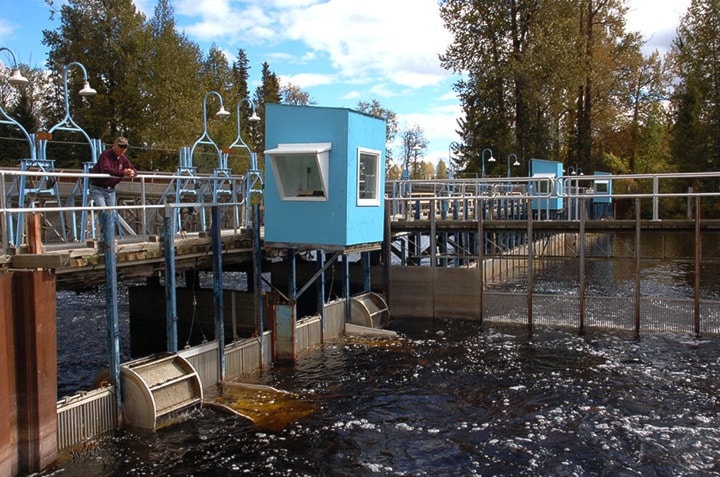The main Fulton River Spawning Channel is full and at capacity with spawning sockeye salmon.
"The news here at Fulton is good. The fish arrived on time, they arrived healthy and we had enough to load the big channel to capacity," said Facility Manager Colin Harrison.
Harrison says the main channel is loaded with 121,000 large, four to five year-old sockeye and 124,000 jacks, two or three year old males - as of last week Tuesday.
"We kept our target number. The river won't be filled to capacity just due to the low amount of sockeye returning," he said.
Harrison says they counted 60,000 large adult sockeye and 40,000 jacks which swam through to spawn in the natural Fulton River.
The Pinkut Creek Spawning Channel loaded 20,000 large sockeye into the channel and 10,000 into the natural Creek.
In addition to those, 20 to 30,000 sockeye spawn in the gravel around the island at the mouth of the Fulton River before the counting fence, Harrison said.
Kirsten Ruecker, Communications Advisor for the Fisheries and Oceans Canada, says the latest available estimate is 360,000 sockeye that returned to the Skeena River, and the final run size will be available in December.
"We didn't know [what to expect]. All we knew was that they were predicting a very poor year. And actually what they predicted was pretty much right on with what did come into the Babine system," Harrison said.
"It was a low return this year.
"Four years ago we produced our normal millions of fry out of these systems, and clearly the number didn't come back this year to the system. So there's obviously something amiss in between," he said, adding that it's hard to pin down what it is.
But the notion that the sockeye return has never been as low as this year has been challenged by a 2012 report, released by Fisheries and Oceans Canada.
The report, titled 'Update Assessment of Sockeye Salmon Production from Babine Lake, British Columbia,' was prepared by the Prince Rupert Fisheries and Oceans Canada North Coast Stock Assessment Unit.
It reports that the actual lowest recorded sockeye return on Babine Lake was in 1955, with a return of only 71,352 sockeye.
This was previous to the operation of the Granisle mine from 1966 to 1982, and the Bell mine from 1972 to 1992. Some of the largest returns, according to the data, occurred during the active life of the Bell mine.
The report cites the complexity of the factors influencing sockeye return on Babine Lake, and it does not discount the possibility that the cumulative effect of logging and mining in the area may have affected current returns.

While fisheries investigate the low numbers of returning sockeye, Harrison says they have found an unusually high number of returning jacks (young males) to the Babine channels.
"We normally get about 10 percent jacks to large adults, but this year we've got basically one-to-one, which is interesting."
At Pinkut Creek the ratio was even higher, with four or five jacks per large salmon, Harrison said.
"It was just impossible [to count]. That's something that we don't normally see.
"What it probably means to us is that because of the large amount of three-year-olds this year, we'll probably get a large amount of four-year-olds next year. Something has happened, there's been good survival throughout the cycle.
"A lot of threes this year, so we'll except a good amount of fours next year," he said.
Harrison says the smaller channel at Fulton, Channel #1, which has a capacity of 20 to 25,000 large sockeye, is closed this year due to damage to the channel and the low numbers of salmon that were expected to return.
Harrison says two years ago the high water in the spring plugged the intake. They worked on it this year but it was fixed too late for them to do the gravel cleaning and preparation they always do prior to loading the fish.
Because they knew there was going to be a small return, and they didn't know if they would even be able to load the big channel, they decided to leave the channel for the year, he said.
Harrison says the timing of the sockeye was normal this year, with the peak spawning time last week and now most of them dying off after burying their eggs safely in the gravel.
